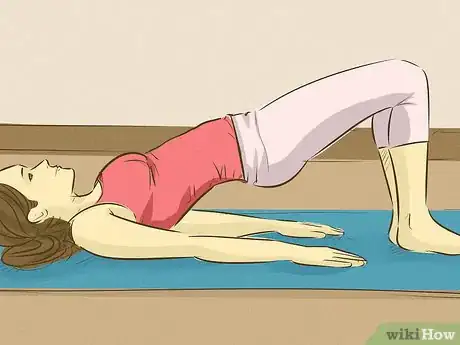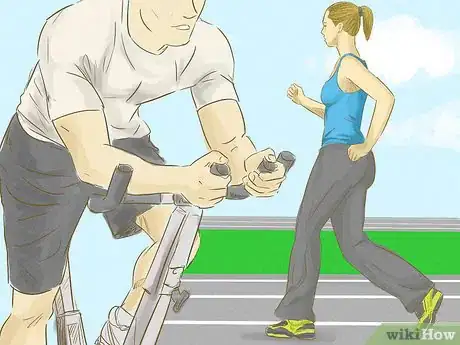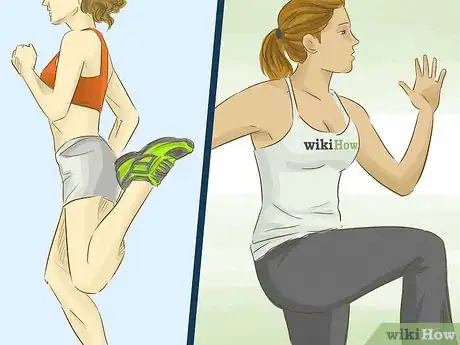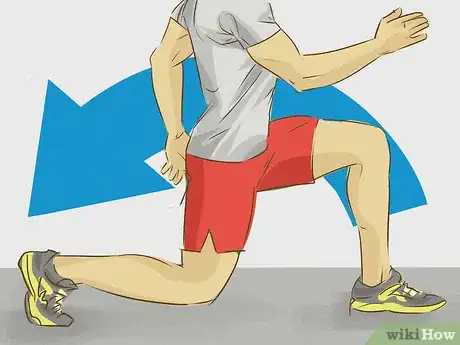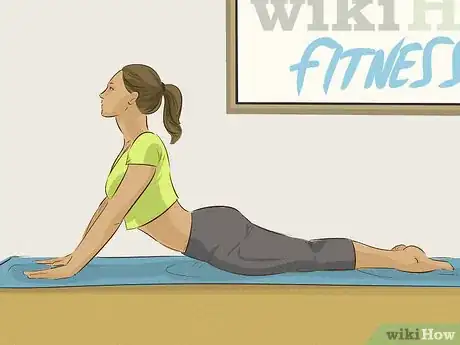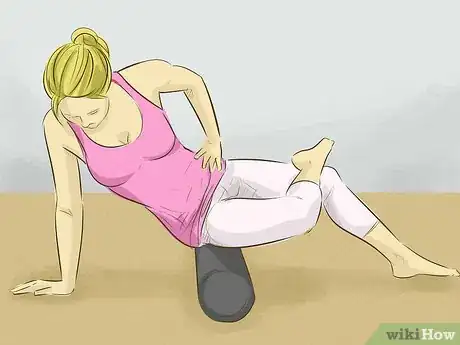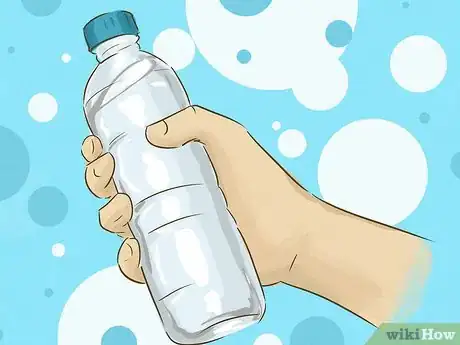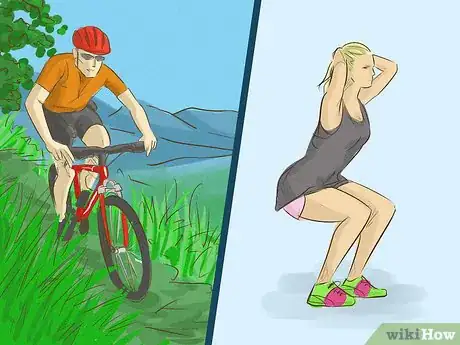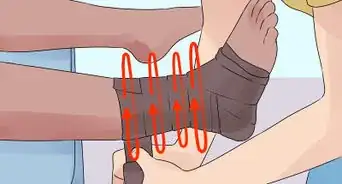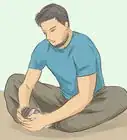This article was co-authored by Monica Morris. Monica Morris is an ACE (American Council on Exercise) Certified Personal Trainer based in the San Francisco Bay Area. With over 15 years of fitness training experience, Monica started her own physical training practice and gained her ACE Certification in 2017. Her workouts emphasize proper warm-ups, cool-downs, and stretching techniques.
There are 11 references cited in this article, which can be found at the bottom of the page.
This article has been viewed 293,176 times.
Have you ever envied your favorite athlete? Getting ready to work out the perfectly toned body? Lifting big weights or running huge distances isn't going to come without proper warm up, and injuries will set you back if you're not careful. Luckily, warming up well is easy, and only takes 10-15 minutes of your time.
Steps
Warming Up For Lifting
-
1Work up a light sweat before starting, not after. Warming up is not just an expression -- you actually want to heat up your body. Warm muscles are looser and thus stretch better without the risk of injury. Get on your favorite cardio machine and move for 5-15 minutes, working your heart rate up as well. Of course, you should think about adjusting your warm up depending on the activity:
- If you're going to be running, a light jog or bike ride is far and away the best warm up.
- If you're lifting, jog for 15-20 minutes. Then do a few very easy reps in your muscle group, or full-body reps like push-ups and pull-ups.
- Even if you're just doing arm day, a good warm up is key. A higher heart rate will send essential blood to your tired muscles as you lift.[1]
-
2Bend and flex to get your joints, tendons, and body loose. Exhaling as you bend, drop down with a curved back and reach for the floor. Then bend backward as well, exhaling and slowly arcing back. Twist from your hips, keeping your feet firmly on the floor, in both directions. Finally, bend sideways, again from the hips. A few other little exercises to try include:[2]
- 20 ankle rotations -- with your weight on the opposite foot, spin your foot from the ankle. Turn in both directions.
- To stretch your neck, flex your head forward/backward, side to side and look right and left.
- Roll your wrists 10 times clockwise, then 10 times counterclockwise.
- Roll and rotate your shoulders. Work in both directions, making as big of circles as feels comfortable.
EXPERT TIPMonica Morris is an ACE (American Council on Exercise) Certified Personal Trainer based in the San Francisco Bay Area. With over 15 years of fitness training experience, Monica started her own physical training practice and gained her ACE Certification in 2017. Her workouts emphasize proper warm-ups, cool-downs, and stretching techniques.ACE Certified Personal Trainer
 Monica Morris
Monica Morris
ACE Certified Personal TrainerOur Expert Agrees: When you're warming up, start with static stretches. That means you're stretching just one muscle, like your arms, your legs, your shins, and your calf muscles. Then, you can move into dynamic stretches, which will get your heart rate going. Those might include doing jump jacks, high knees, or swinging your arms from side-to-side.
Advertisement -
3Do some glute bridges. These may seem useless for a lifter, but your butt muscles are crucial for holding your form and lifting big weights. This warm-up looks ridiculous, but really does have full-body democrats. To do one, lay on the floor with your knees up and feet firmly planted. Then...
- Squeeze your abs and butt muscles together.
- Bring your hips up to the ceiling.
- Keep your shoulders and feet on the floor.
- Do not use your hamstrings to lift yourself.
- Slowly lower back down to the ground.
- Repeat 10-15 times.[3]
-
4Add in some dynamic warm ups. A dynamic warm up is moving your body to stretch instead of "bend and hold," which can cause injury. Dynamic warm-ups simulate the actual movement of your body, just without weight, and they keep your blood moving to activate all of your muscles. Pick at least three of the following:
- 50 jumping jacks
- 20 body weight squats
- 2-3 minutes jump rope
- 5-10 lunges
- 10-15 knee high jumps (jump with both feet and bring knees to chest).[4]
Warming Your Legs
-
1Jog, bike, or do some other form of cardio for 5-10 minutes. You need to slowly work your muscles up to full speed. When warming up, you should run in place, use the stationary bike, or find some other simple cardio machine to get moving.
-
2Use "altered runs," like high knees, to target specific muscles while warming up. Mix high knees, butt kicks, and shuffling into your warm-up run. While they look a little silly, these exaggerated motions are designed to get specific muscle groups firing. By warming up the smaller muscles now, you prevent injury later. Do 25-40 yards of each exercise.
- High Knees: Lift your knee up to stomach height with every step. Focus on landing and springing back up from the balls of your feet.
- Butt Kicks: As you run, kick your own rear with your heel after every step, over-exaggerating the running motion.
- Shuffle Step: Facing sideways, move laterally off the balls of your feet. Keep your spine straight and your shoulders over your ankles. Make sure to focus on both directions.
- Other options: Try out skipping, two-footed leaps, running backward, lunges, and bounding.
-
3Warm up your hip muscles with slow rotations. Don't forget about your hips, which are essential muscles for transferring power and helping you pivot and turn. The following exercises should be done for 15-20 yards each.
- Hip Openers: Walking sideways (side to side), lift your front knee up to your hip. Slowly rotate your knee away from your body, turning you to face the other direction. Repeat with the other foot.
- Hip Closers: Walking laterally, pick up your back leg and rotate it in front of your body. Turn on your other foot so that you face the opposite direction. Repeat.
-
4Do lunges to activate your quads and glutes. These big, powerful muscles are vital for running uphill, jumping, and landing. Get them firing with some lunges:
- Step forward with either foot. The front knee should be bent at a right angle.
- Rest on the toes of your back foot.
- Drop your hips down towards the ground, keeping your front knee bent at 90.
- Keep your spine straight as your drop.
- Slowly raise your hips up.
- Step forward with the opposite foot and repeat.
- Repeat 10-15 times on each side.
- Step forward with either foot. The front knee should be bent at a right angle.
-
5Avoid vigorous static stretching, or "bend and hold" stretching. Static stretching is the classic "grab and hold for 10 seconds" stretch. Many studies show that static stretching can actually decrease by performance by tearing muscle fibers. Note, however, that static stretching is good for cool downs or post-workout stretching.[5] After warming up, limit yourself to a few light 10-15 second stretches on any muscles that are still sore.
- A stretch should never hurt -- don't push yourself through pain to get a "better" stretch. You're only making yourself more injury prone.[6]
Staying Loose and Warmed Up
-
1Stretch during the day, even when not working out. Stretching before bed is often the best time, as it gives you body the rest of the night to recover. Static stretching slightly tears your muscles, but this is actually a good thing -- it clears scar tissue so that your muscles can heal in a smoother, stretchier way. Touch your toes, do some lunges, and stretch out your body every night before bed.
- Light yoga, with an emphasis on holding stretches, is a great way to protect your body and stay loose for workouts.
-
2Roll out or lightly stretch any sore sports. If you're working out frequently, this will be essential, but can be done before the gym, too. Using a foam roller on the floor, use your body weight to roll out your major muscles -- back, thighs, calves, neck. If you find a tender spot, work on it. [7]
-
3Drink water throughout the day. This is the best thing you can do to ensure your body is ready to go when working out. You should have at least one large glass of water an hour before working out, and you should be sipping water before, during, and after the session. This keeps your brain active and you muscles charged and loose.[8]
- Constantly sipping water, instead of chugging it all at once, will keep you hydrated without feeling full.
- If you feel thirsty, you're already dehydrated. Try to stay ahead of thirst.[9]
-
4Have a light meal roughly 1-2 hours before working out. This depends a bit on what type of workout you're doing, but the basics are the same. A meal low in fat and high in protein -- PB&J and banana, protein shake, grilled chicken salad, tuna fish, etc. -- will give you the energy you need to work out at your best. This is the part of warm-up many people neglect, thinking they should wait to eat until after they work out.
- If running, try to eat roughly two hours before leaving.
- If lifting, you can eat closer to an hour.
- Your goal is to be just a little bit hungry, or perfectly content when you start. You shouldn't be full or starving. If you need, eat a small bar, pack of pretzels, or another simple carb 20-30 minutes before working out for a little boost.[10]
-
5Mix up your workouts to ensure your muscles are healthy, happy, and loose. Different motions and workouts will develop subtly different parts of your muscles. More importantly, it expands your "range of motion," or the area you can reach with each muscle. Having different exercises will allow you to develop strength and flexibility more naturally, leading to overall higher health and strength.
- That said, you should keep your warm up roughly the same -- a little routine is not a bad thing if it helps you stay loose.[11]
Warnings
- A pulled muscle can hurt a lot so be careful not to overdo it!⧼thumbs_response⧽
- Don't do a stretch if you don't know how to do it right.⧼thumbs_response⧽
References
- ↑ http://www.muscleandfitness.com/workouts/workout-tips/bulletproof-your-body-ultimate-warm
- ↑ http://www.active.com/running/articles/before-you-run-the-dynamic-warm-up
- ↑ http://www.muscleandfitness.com/workouts/workout-tips/bulletproof-your-body-ultimate-warm?page=2
- ↑ https://www.nerdfitness.com/blog/2012/01/09/warm-up/
- ↑ http://www.nytimes.com/2008/11/02/sports/playmagazine/112pewarm.html?_r=0
- ↑ http://www.sharecare.com/health/stretching-exercise-warm-up/should-stretching-hurt-when-done
- ↑ http://www.muscleandfitness.com/workouts/workout-tips/bulletproof-your-body-ultimate-warm?page=3
- ↑ http://www.active.com/nutrition/articles/how-to-hydrate-before-during-and-after-a-workout
- ↑ https://www.nerdfitness.com/blog/2012/01/09/warm-up/
About This Article
To warm up before a workout, spend a few minutes stretching to loosen your muscles. Stretch your hamstrings by bending down to touch your toes. Be sure to keep your legs and arms straight. Then, twist your hips and bend sideways to loosen up. Then, do some dynamic exercises, like 20 jumping jacks, 10 squats, or 10 lunges. This will get your blood pumping and activate the muscles in your body. If you’re going to be running or working out your legs, you’ll also want to run in place or ride a stationary bike for 5 minutes so your legs are warmed up. For more advice, including how to stay loose and warmed up throughout the day, keep reading.


